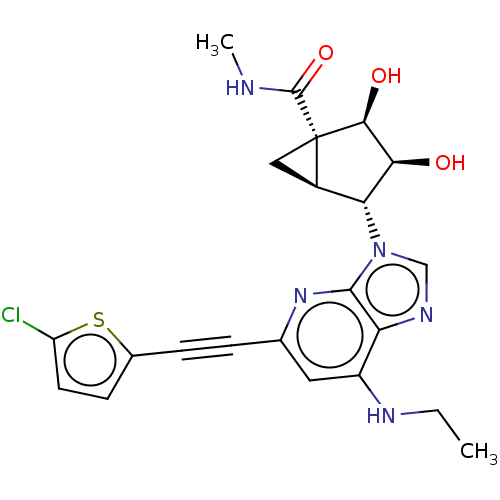TargetAdenosine receptor A3(Homo sapiens (Human))
National Institute Of Diabetes And Digestive And Kidney Diseases
Curated by ChEMBL
National Institute Of Diabetes And Digestive And Kidney Diseases
Curated by ChEMBL
Affinity DataKi: 1.70nMAssay Description:Displacement of [125I]N6-(4-amino-3-iodobenzyl)adenosine-5'-N-methyluronamide from human adenosine A3 receptor expressed in CHO cell membranesMore data for this Ligand-Target Pair
TargetAdenosine receptor A3(Mus musculus)
National Institute Of Diabetes And Digestive And Kidney Diseases
Curated by ChEMBL
National Institute Of Diabetes And Digestive And Kidney Diseases
Curated by ChEMBL
Affinity DataKi: 16nMAssay Description:Binding affinity to mouse adenosine A3 receptor expressed in HEK293 cell membranesMore data for this Ligand-Target Pair
TargetAdenosine receptor A3(Mus musculus)
National Institute Of Diabetes And Digestive And Kidney Diseases
Curated by ChEMBL
National Institute Of Diabetes And Digestive And Kidney Diseases
Curated by ChEMBL
Affinity DataKi: 16nMAssay Description:Concentration required to inhibit binding of ICAM-1 to LFA-1 (Leukocyte function-associated antigen-1), evaluated ELISAMore data for this Ligand-Target Pair
TargetAdenosine receptor A3(Canis lupus familiaris)
National Institute Of Diabetes And Digestive And Kidney Diseases
Curated by ChEMBL
National Institute Of Diabetes And Digestive And Kidney Diseases
Curated by ChEMBL
Affinity DataKi: 49nMAssay Description:Binding affinity to canine adenosine A3 receptor expressed in HEK293 cell membranesMore data for this Ligand-Target Pair
TargetAdenosine receptor A3(Homo sapiens (Human))
National Institute Of Diabetes And Digestive And Kidney Diseases
Curated by ChEMBL
National Institute Of Diabetes And Digestive And Kidney Diseases
Curated by ChEMBL
Affinity DataEC50: 1.5nMAssay Description:Agonist activity at human adenosine A3 receptor expressed in CHO cells assessed as inhibition of cAMP productionMore data for this Ligand-Target Pair

